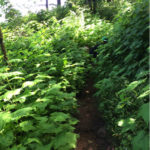By Patrick Keavney, Crew Leader, Trailkeepers of Oregon A lot of us see trails that rarely get a good brushing as we’re out hiking. At a recent TKO fundraiser, a hiker asked me the best way to…

Slough and trail creep on the Wygant Trail near Mitchell Point, Columbia River Gorge. The arrow shows where the uphill edge of the trail should be.
Almost every hiking trail in the Northwest has been worked on by a volunteer group. Trailkeepers of Oregon’s robust network of volunteers maintain the trails that we all love to hike, correcting problems and improving the overall hiking experience. Most people who have done trail work say that they will never look at a trail the same way again. But you don’t have to join a work party to begin developing “trail eyes” (although we would love to have you!). Here are some things to watch for as you hike.
Trail creep
Trails on steep slopes tend to narrow over time. Dirt, rocks, needles, and leaves slough downhill onto the trail surface, narrowing the tread and forcing hikers to the outside edge. The trail slowly creeps toward the outside, making the trail narrower and, in many cases, more treacherous.
Brush on trail
Salmonberry and other leafy plants spread over many trails as they

Thimbleberry and other brush crowding Gorge Trail No. 400 near Moffett Creek, Columbia River Gorge.
grow their spring foliage, sometimes narrowing the tread width by half. Most hiking trails are designed to be three to four feet wide. New growth on the uphill side of the trail usually pushes hikers toward the outside of the trail, where they redefine the tread and create trail creep. Trees like alder or large vine maple sometimes hang down low enough to hit hikers or horse riders as they pass.
Drainage

Water flowing down the trail bed on the River to Rock Trail, Beacon Rock State Park. The arrow shows the water’s path.
Noting the path of water along a trail is an important component of trail eyes. Astute hikers can see the path that water takes, even when hiking in dry weather. Look for evidence of rivulets or U-shaped layers of needles along a trail where running water has pushed them along the trail surface.
Often trails are designed with drainage ditches along the uphill edges. The ditches collect water and direct it into drain dips that cross the trail or go downhill at switchback turns. These ditches often fill with organic debris, impeding water flow and forcing water to take new paths, sometimes across the trail itself. The downhill edges of drain dips also collect organic material, slowing the flow of water off the trail.
How you can help

A drainage ditch clogged with debris and plant growth, Latourell Falls, Columbia River Gorge.
Land managers and volunteer organizations such as TKO rely heavily on trip reports from hikers to plan and prioritize work parties. A large log across a trail or a slide blocking it are obvious problems often reported by hikers. They are high priority. Lower-priority problems such as trail creep, foliage crowding the trail, or blocked drainage are less obvious but are still important enough to mention.
Hikers can report trail problems on the Oregon Hikers Trail Rx Forum. Pictures are always helpful, and so is a note about where on the trail the problem is. GPS coordinates are great, but even without coordinates, a description of landmarks or the approximate distance from the trailhead helps managers and crew leaders to scout the trail, evaluate the situation, and plan the work needed.
Next time you hike, put on your new trail eyes, enjoy your hike, and report any problems that you see. Enjoy!
—Elaine Keavney
